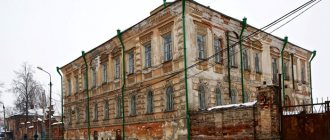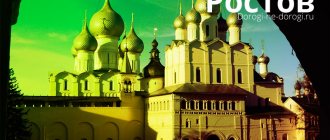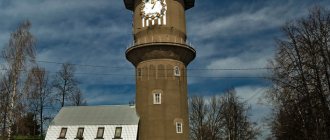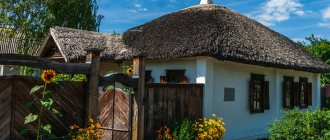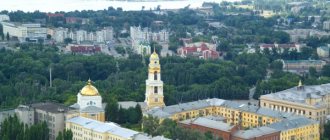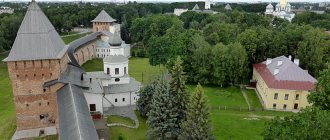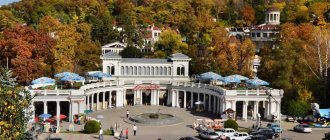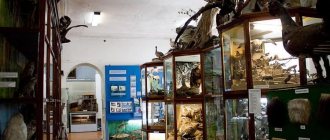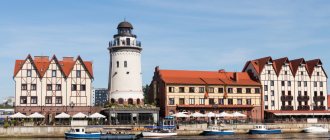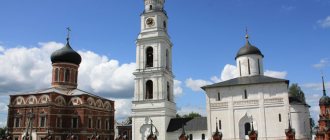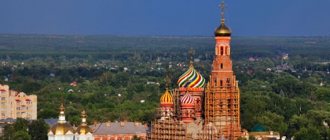Zenkovsky Park of Culture and Leisure
The park was opened in June 1933, it was created by the citizens. Currently, its area is 200 hectares, and there is also a lake here. Throughout the park there are various fairy-tale characters and houses carved from cedar. In this area there are two sanatoriums, two children's health camps and even a riot police squad base. There is an equestrian center in the park in such areas as tourism, horseback riding, and military affairs. In the summer, the park offers various attractions, tennis courts, and sports equipment rentals. Visitors can enjoy a helicopter flight over the city. In winter, a ski rental center and an ice skating rink are open here.
Cathedral of the Nativity of John the Baptist
On the opposite part of the road, in a forested area, there is the Cathedral of the Nativity of John the Baptist.
External mosaic on the walls of the Cathedral.
The cathedral is only 10 years old, but there is an old temple nearby, and from everything you can see that it is much older.
Sights of Prokopyevsk: description and photos
Among the attractions of Prokopyevsk, the Monument of Glory should be noted. It was installed in Zenkovsky Park in honor of the 40th anniversary of Victory Day. Not long ago the obelisk was reconstructed. There is another landmark of Prokopyevsk in the park - “11 blockade pines”, it is considered the same age as Victory. In 1942, at the height of the war, children from besieged Leningrad were evacuated to Prokopyevsk, who lived here until the end of the war. After the defeat of the fascist troops, the children, before leaving for Leningrad, planted eleven pine trees (according to the number of those caring for them in the orphanage) in the form of a broken blockade ring.
Prokopyevsky Drama Theater
The theater can be considered a real landmark of Prokopyevsk; it was built in the 60s of the last century and bears the name of the Lenin Komsomol. The building itself is unusual, made in the “Stalinist Empire” style. The theater has a young talented team that often goes to festivals and receives prestigious awards. Theater troupes from different cities come to this theater on tour. With the support of the theater, interesting flash mobs are held. It is noteworthy that on Thursdays in June only comedies are shown here.
The halls display completely unique birch bark products and an exhibition of dolls. All exhibits were made by craftsmen from Prokopyevsk. Works by famous painters from different times are also exhibited here. All kinds of master classes are held for all ages.
Museum of Local Lore
Another attraction of Prokopyevsk can be considered the local history museum. It was originally opened on the basis of a school. Students conducted more than 20 different expeditions in the south of the region. In 1961, thanks to the collected collections, a state museum was opened. The exhibition includes the following departments:
- archeology;
- ethnography;
- nature;
- revolution;
- Civil War;
- Patriotic War;
- space.
The museum provides walking and bus tours of the sights of Prokopyevsk from different times. Museum employees also provide other services: theatrical performances, wedding ceremonies.
Monument on the Alley of Heroes
While in the city, you should visit another attraction of Prokopyevsk - a monument to soldiers who died in hot spots. A large black tulip is located under the canopy of the parachute. The monument is located on the Alley of Heroes.
In the city of Prokopyevsk there are many different monuments:
- Peter I;
- St. Peter and Fevronia;
- Jesus Christ the Savior;
- liquidators of the Chernobyl nuclear power plant;
- plumbing.
The Aba River is one of the attractions of Prokopyevsk. The river flows through the city and has a picturesque view. Here you can relax from the bustle of the city and enjoy nature. Aba is considered a fish river: pike perch, pike, carp, and crucian carp live in it.
Winter. Church of the Intercession of the Blessed Virgin Mary
On Ziminka there is a very nice wooden church of the Intercession of the Blessed Virgin Mary, it’s a pity we didn’t get inside.
The main attractions of Prokopyevsk with photos and descriptions
The city of Prokopyevsk is located in the south of the Russian Federation in the historical region called Western Siberia, in close proximity to Novokuznetsk, Kemerovo region. This is the largest mining center. Despite the fact that the city lies far from the places beloved by tourists in Russia, there is no special advertising to lure people into it; there is something to see and how to relax.
Interesting places for tourists are concentrated closer to the southern outskirts of the city. There is a widely developed network of technical educational institutions here.
You can have fun in amusement parks, enjoy the silence and nature near ponds and on shady paths.
Story
- Initially, on the territory where Prokopyevsk now stands, there was the village of Monastyrskaya , which later became a village with the same name for the city.
- The village of Prokopyevskoye , the place where the city originated, received its name from Procopius of Ustyug, a miracle worker and saint of the Russian Orthodox Church.
- In 1911, the village was the center of a volost that bore the same name.
- The city was built on the basis of 23 villages in the region .
- The territory crosses complex terrain . The highest point, in the western part of the city, is 470 m above sea level . The center is located at 270-300 m , and the eastern part - up to 350 m . Thus, elevation changes are observed throughout the city.
- According to some sources, the history of the city began with a mine located on its territory.
Prokopyevsk Local History Museum
If this is your first time traveling through the distant Siberian region and you have not passed the small provincial town of Prokopyevsk, then you will not regret it. Even if you can hardly be called a fan of visiting museums, then in Prokopyevsk you need to go to the city’s local history museum to learn more about its history and customs.
The museum has been operating since the summer of 1961. The organization operates a society for young historians, which makes scientific discoveries, conducts archaeological and paleontological expeditions, and travels to places of military battles.
Finding the museum is not difficult; it is located at 63 Shakhtyorov Avenue, in a residential building on the ground floor.
The museum's exhibition is very diverse, regularly replenished and divided into halls. One exhibition is on a permanent basis, the other is changing. Here you can learn about history, specialization, the nature of the city, coal mining technology, and you can also be transported into space to look at spacecraft. The time of the excursion will fly by.
Depending on the wishes of museum guests, a sightseeing, thematic or interactive tour is offered. You can also view the exhibits yourself.
The museum is open every day except Mondays from 10:00 to 17:00.
Notes
- ↑ 12
OKATO 32 437 - ↑ 12
Law of the Kemerovo region “On the administrative-territorial structure of the Kemerovo region” - ↑ 123
Charter of the municipal formation "Prokopyevsky urban district" - ↑ 123
The permanent population of the Russian Federation by municipalities as of January 1, 2021 (Russian). Date accessed: April 27, 2021. Archived May 2, 2021. - ↑ 123
General plan of the city of Prokopyevsk - Glotov G. A. The future of Kuzbass cities
- All-Union Population Census 1939 – Demoscope
- History of Prokopyevsk
Drama Theater
Continuing the tour of the city, the Prokopyevsky Drama Theater, which bears the name of the Lenin Komsomol, will be interesting. This is the only theater in the city. Also located at 35 Shakhtyorov Avenue and crowned by a large pedestrian square. It looks very grandiose with columns in the Stalinist Empire style. The theater is valued for its performances, and the cast is famous throughout the country. Locals and tourists call the theater a unique creation of those parts. In addition to its actors, theater troupes often come to the theater on tour.
With the support of this institution, various flash mobs are often held in the city, and on Thursdays in June only comedies are staged.
The theater has its own website where you can view the poster and purchase tickets online.
Population
- The city is the third most populous in the Kemerovo region. More than 190 thousand people live on its territory .
- Prokopyevsk ranks 99th in the ranking of Russian cities by population.
- The average age of the city's population is 40 years . The reason is the outflow of young people to, in their opinion, more promising areas of the country.
Such famous people as:
- Professional athlete Thaiboxer, four-time world champion – Artem Vakhitov .
- Pilot-cosmonaut, twice hero of the USSR - Boris Volynov .
- Famous cybernetics scientist - Boris Lobanov .
- Actor – Oleg Chernov .
- Four-time Olympic champion in skiing, nine-time world champion, 39-time champion of the USSR - Galina Kulakova .
- Composer: Sergei Kaidan-Deshkin .
- World hockey champion - Sergei Zinoviev .
Tramway Museum
If you want to visit a museum, then give preference to the unusual tram history museum in the city. It is small but interesting. Here you can see models of carriages from different years and talk about the management of tram lines. If you have free time, visit the museum.
Few tourists like to wander aimlessly along the city streets, but you won’t get bored in Prokopyevsk. There are many monuments here, from traditional to modern inventions, in the form of dynamic, almost living compositions. As everywhere else, almost every monument has a place where, by touching, dreams come true. They can be identified by their polished surface. Don't miss the opportunity to make your dreams come true.
The main monuments of the city include:
- Monument to a plumber. This bronze monument has been in the city since 2010. The locals gave him the name Sanych. Located in Communal Workers Alley.
- Monument to Adam and Eve as a symbol of fidelity and love in a couple. It appeared not so long ago, in 2011. The composition consists of a tree on which the Serpent is hiding, in the center there are two figures of a man and a woman. A large fountain located nearby harmoniously continues the romantic atmosphere. The composition is located on Gagarin Street.
- At 43 Stroiteley Avenue, a plumber is waiting for you to rescue a kitten from an electrical line.
- The great Emperor Peter I took its place opposite the city administration building. It is located at 41 Shakhterov Avenue.
- An interesting composition, under the parachute canopy, is a memorial site for Russian soldiers who fell in hot spots around the planet. The monument is located on the Alley of Heroes.
- Peace in the city is solemnly preserved by the sculpture of Jesus Christ the Savior of the World. The 10 Commandments are engraved on the pedestal underneath. The monument is located on Stroiteley Avenue.
- The memory of the liquidators of the Chernobyl accident was also honored with an unusual monument. Located on the Alley of Heroes.
- The monument to St. Peter and Fevronia protects families and cherishes love. The monument is located in the Student Park.
Tyrgan
This is the name of the central and largest district of the city, which is also the most modern and the most dynamically developing. Here you can climb the mountain - the highest point of the city - and look at the view. There are many interesting sculptures and shopping centers in this area.
The highlight is the Youth Park with attractions, sports and playgrounds, beautiful trails and an alley of heroes.
Holiday calendar, signs, dates and events for every day of the year - folk calendar, Orthodox calendar, church calendar, eastern calendar, astrological calendar, lunar calendar, industrial calendar, state and professional holidays, including significant World and International holidays and public holidays, folk holidays and omens, and other equally interesting and unusual holidays, dates and events of the year, zodiac signs, dream books, and much more.
Calendar is a system for counting long periods of time, based on the periodicity of such natural phenomena as the change of day and night, the change of phases of the Moon , change of seasons.
Calendar - (from Latin Calendarium - debt book) a system for counting large periods of time, based on the visible movements of celestial bodies. The cyclic movement of such astronomical objects as the Earth, the Sun and the Moon is of primary importance for the construction and understanding of calendars. The word “calendar” itself comes from the Latin caleo (to proclaim), calendae (first day of the month) and, in fact, calendarium (debt book). A calendar is usually called a system of counting long periods of time based on the periodicity of natural phenomena, dividing them into shorter periods: millennia, centuries, years, months, weeks and days.
Calendar - (from Latin calendae or kalendae, “calends” - the name of the first day of the month among the ancient Romans), a way of dividing the year into convenient periodic time intervals. The main tasks of the calendar are: a) fixing dates and b) measuring time intervals.
The first calendar arose a long time ago, in ancient times, because there was a need to measure time. The word calendar comes from the Latin words caleo - to proclaim and calendarium - debt book. In Ancient Rome, debtors paid interest on the day of the calendar, the first days of the month) - a number system for large periods of time based on the periodicity of the movement of celestial bodies: the Sun - in solar calendars, the Moon - in lunar calendars, and at the same time both the Sun and the Moon in lunisolar calendars .
The calendar allows you to record historical and social events in their chronological sequence. One of the important tasks of the calendar is to determine the moments of church events, moving and non-moving holidays (for example, Easter).
There are three main types of calendars: 1) lunar, 2) solar and 3) lunisolar.
1. Lunar calendar, which is based on a synodic lunar month with a duration of 29.5 average solar days. Originated over 30,000 years ago. The lunar year of the calendar contains 354 (355) days (11.25 days shorter than the solar one) and is divided into 12 months of 30 (odd) and 29 (even) days each (Muslim, Turkish, etc.). The lunar calendar is adopted as a religious and state calendar in the Muslim states of Afghanistan, Iraq, Iran, Pakistan, the United Arab Republic and others. Solar and lunisolar calendars are used in parallel for planning and regulating economic activities.
2. Solar calendar, which is based on the tropical year. Originated over 6000 years ago. Currently accepted as the world calendar. For example, the “old style” Julian solar calendar contains 365.25 days. Developed by the Alexandrian astronomer Sosigenes, introduced by Emperor Julius Caesar in Ancient Rome in 46 BC and then spread throughout the world. In Rus' it was adopted in 988 NE. In the Julian calendar, the length of the year is determined to be 365.25 days; three “simple” years have 365 days each, one leap year has 366 days. There are 12 months in a year of 30 and 31 days each (except February). The Julian year lags behind the tropical year by 11 minutes 13.9 seconds per year. The error per day accumulated over 128.2 years. Over 1500 years of its use, an error of 10 days has accumulated.
In the “new style” Gregorian solar calendar, the length of the year is 365.242500 days (26 seconds longer than the tropical year). In 1582, the Julian calendar, by order of Pope Gregory XIII, was reformed in accordance with the project of the Italian mathematician Luigi Lilio Garalli (1520-1576). The counting of days was moved forward by 10 days and it was agreed that every century that is not divisible by 4 without a remainder: 1700, 1800, 1900, 2100, etc. should not be considered a leap year. This corrects an error of 3 days every 400 years. An error of 1 day “accumulates” in 3323 years. New centuries and millennia begin on January 1 of the “first” year of a given century and millennium: thus, the 21st century and the 3rd millennium AD began on January 1, 2001 according to the Gregorian calendar.
In our country, before the revolution, the “old style” Julian calendar was used, the error of which by 1917 was 13 days. On February 14, 1918, the world-accepted “new style” Gregorian calendar was introduced in the country and all dates moved forward 13 days. The difference between the old and new styles was 11 days in the 18th century, 12 days in the 19th century, and 13 days in the 20th century - this will persist until 2100.
The solar calendar is usually based on four main dates - two equinoxes and two solstices. The accuracy of a calendar is determined by how accurately the equinox falls on the same day each year. The lunisolar calendar is an attempt to harmonize the length of the lunar month and the solar (tropical) year through periodic adjustments. To ensure that the average number of days per year according to the lunar calendar corresponds to the solar year, a thirteenth lunar month is added every 2 or 3 years. This trick is required to ensure that the growing seasons fall on the same dates each year.
3. Lunisolar calendar, in which the movement of the Moon is coordinated with the annual movement of the Sun. The year consists of 12 lunar months of 29 and 30 days each, to which “leap” years containing an additional 13th month are periodically added to take into account the movement of the Sun. As a result, “simple” years last 353, 354, 355 days, and “leap” years last 383, 384 or 385 days. It arose at the beginning of the 1st millennium BC and was used in Ancient China, India, Babylon, Judea, Greece, and Rome. Currently adopted in Israel (the beginning of the year falls on different days between September 6 and October 5) and is used, along with the state one, in the countries of Southeast Asia (Vietnam, China, etc.).
Next: History of calendars...
Zenkovsky Park
A wonderful place to relax when you want more nature is Zenkovsky Park on Kustarnaya Street, 35. Even people from other cities in the country come here.
Everything here is enveloped in the aroma of pine trees and the singing of birds. In winter you can have fun at the ski resort, and in summer you can find any entertainment you like, from tennis to water activities. Everything here is very well thought out in terms of location, there are many cafes. In addition to everything, the park has a huge pond where you can swim or admire the view.
This is the name of the central and largest district of the city, which is also the most modern and the most dynamically developing. Here you can climb the mountain - the highest point of the city - and look at the view. There are many interesting sculptures and shopping centers in this area.
The highlight is the Youth Park with attractions, sports and playgrounds, beautiful trails and an alley of heroes.
This river flows through the city and adds picturesque places for relaxation. You can come here when you want to retire, get away from the bustle of the city, or just enjoy nature. In these places you will forget about your problems and recharge your batteries.
Prokopyevsk is a place where every tourist will find entertainment to suit their taste.
Territory
- The area of the city reaches 227.5 square meters. km . For comparison, you can take the largest city - Moscow, whose area is 5 times .
- The territory crosses complex terrain. The highest point in the Western part of the city is 470 m above sea level. The center is located at 270-300 m , and in the eastern part the heights reach 350 m . Thus, significant elevation changes are observed throughout the city.
- There were once 16 coking coal mines . In 2021, the last mine, named after Dzerzhinsky, .
- The territory belongs to the south of the Siberian part of the country. That is why there are cold winters and hot summers. Temperature changes have been particularly pronounced in recent years.
- The city has an amazing natural monument, which is popularly called “Field of Miracles” . Here you can find minerals dating back to the Paleozoic era. Previously, on the territory of the city, according to paleontologists, there was a warm sea in which cephalopods, bryozoans, brachiopods, crinoids and sea urchins lived. Today, on the territory of this unique natural monument, you can find various fossils of the distant past.
- On the territory there is Mount Barsuk (Badger Mountain). Its highest point reaches 576 m , and at the very top there is a hoisted flag of the city.
- The Tyrgan district is considered the largest and most developed center . It is filled with attractions, shopping centers, alleys, playgrounds and parks.
